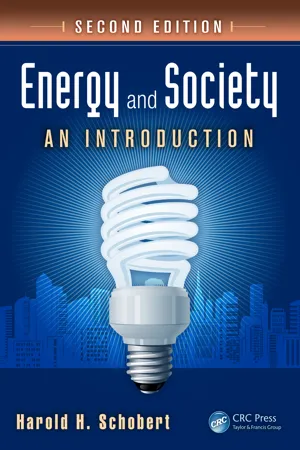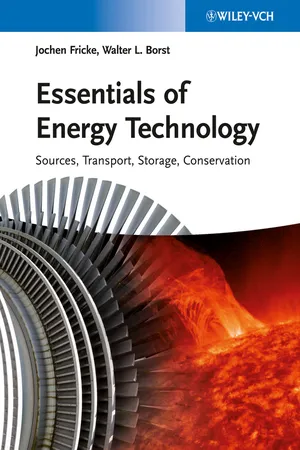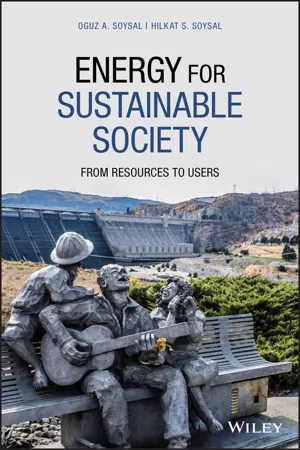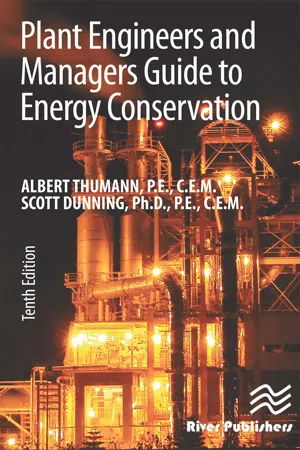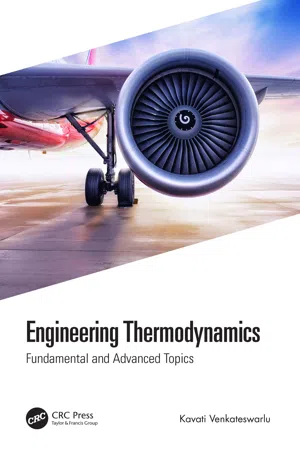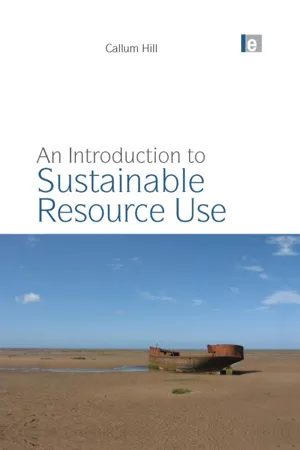Physics
Thermal Efficiency
Thermal efficiency is a measure of how well a device converts heat energy into useful work. It is calculated by dividing the useful output of the device by the input heat energy. A higher thermal efficiency indicates that a greater proportion of the input energy is being converted into useful work, making the device more efficient.
Written by Perlego with AI-assistance
Related key terms
Related key terms
1 of 4
Related key terms
1 of 3
7 Key excerpts on "Thermal Efficiency"
- Lars O. Nord, Olav Bolland(Authors)
- 2020(Publication Date)
- Wiley-VCH(Publisher)
7 Power Plant Efficiency CalculationsThere is diversity in the methodology for calculating power plant efficiencies, which causes a lot of uncertainty when comparing plant options. Several terms are used inconsistently, and often with a lack of definition, for the term efficiency. Terms such as ‘efficiency’, ‘Thermal Efficiency’, ‘cycle efficiency’, ‘process efficiency’, ‘net/gross efficiency’, ‘net plant efficiency’, ‘electrical efficiency’, ‘total efficiency’, ‘exergy efficiency’, ‘second law efficiency’, ‘fuel efficiency’, and ‘fuel utilisation’ are used, some of them are interchangeable. In addition, many publications dealing with efficiencies give insufficient information about the computational assumptions, e.g. pressure drop, heat loss, temperature differences, and component efficiencies. Further, different software is used with various thermodynamic property models. The definition of system boundaries is often omitted. The diversity observed in efficiency calculation methods is not peculiar to power plants with CO2 capture but can be observed for energy conversion process analysis in general. In the following, an attempt is made to clarify efficiency calculations.7.1 General Definition of Efficiency
Efficiency is the ratio between two energy quantities: the numerator being the energy product of the process and the denominator being the energy input to the process.The energy product from a power plant is the power (or electricity) being delivered at a given boundary. It may also be both power and heat in the case of a cogeneration plant. When there is more than one energy product, the efficiency often becomes confusing, as energy products of different thermodynamics and economic values are added together. In some cases, one of the products of the process may be a substance, such as hydrogen or methanol.The energy input- eBook - ePub
Energy and Society
An Introduction, Second Edition
- Harold H. Schobert(Author)
- 2014(Publication Date)
- CRC Press(Publisher)
low, respectively.The pool of water at the bottom of the waterfall still had some ENERGY . Analogously, the cold side of the steam engine still contains heat. Conceptually, more WORK could be extracted from the water in the pool until all the available gravitational potential energy of the water was used up—until we had reached the center of the Earth, which is the zero point of gravitational energy. Quite similarly, suppose that the condenser on a steam engine is at, say, 25°C. The water produced in the condenser could, in principle, be cooled further and further, until we reached a point at which no more work could be extracted from it. This point would be the temperature analog of the center of the Earth, the zero point of potential energy below which it is impossible to go. In a thermal system, this zero point of energy is the temperature called absolute zero. The total energy of the thermal system would be represented by the difference between the temperature of the hot side and absolute zero: Th − 0, or, simply Th .The heat engine efficiency is a measure of the ENERGY that can be converted to WORK as a fraction of the total ENERGY . This concept can be expressed mathematically in an equation for calculating efficiency:η =()T h−T 1T hUsing this equation, the numerical value of efficiency will be a fraction having a value between 0 and 1. Often it is more convenient or easier to express efficiency as a percentage, rather than as a fraction. This is done readily by using the comparable formula:% η = 100()T h−T 1T hIn this case, efficiency has a value between 0% and 100%. The equations are equivalent and provide the same information; the difference is whether the calculated efficiency is expressed as a fraction or as a percentage. However, there is one crucial fact in the use of efficiency calculations: these equations only provide the correct answer if the temperature is expressed in kelvins - eBook - ePub
Essentials of Energy Technology
Sources, Transport, Storage, Conservation
- Jochen Fricke, Walter L. Borst(Authors)
- 2013(Publication Date)
- Wiley-VCH(Publisher)
Chapter 3
Thermodynamic Energy Efficiency
The conversion of most forms of primary energy to useful energy is still highly inefficient today. Only about one-third of the primary energy is actually put to use (Figure 3.1 ). There are several reasons for this: relatively low energy costs (especially in the United States), marginal incentives for higher efficiency, and fundamental thermodynamic limitations.(Source: Adapted from Ref. [1].)Figure 3.1Typical flow of energy in an industrialized country, here Germany. Most primary energy comes from coal, natural gas, oil, and uranium. The end energies are electricity, gasoline, and diesel fuel, for industry, trade, heating and air conditioning, transportation, and so on.3.1 Carnot's Law
The proper application of thermodynamics is the key for higher energy efficiency. The upper limit for the conversion of heat into useful work is given by Carnot's law:3.1where ηC is the energy efficiency of the Carnot engine (Figure 3.2 ) operating between two reservoirs at absolute temperatures Th (hot) and Tc (cold). First described by Sadi Carnot in 1824, this law shows that the higher the temperature Th is for a fixed Tc , the higher is the efficiency. In the Carnot engine, all processes are assumed to be reversible and infinitely slow so that the system is in equilibrium at all times.Figure 3.2(a) Energy flow chart for the Carnot process. (b) Pressure-Volume (pV) diagram. The shaded area of the closed loop is the extracted work W. (c) Temperature–Entropy (TS) diagram. Vertical transitions represent isentropic (adiabatic) processes.Two adiabatic and two isothermal processes make up the closed cycle, in which heat Q34 at high temperature Th is used to produce work W, with heat Q12 discharged at low temperature Tc . The efficiency ηC in Eq. (3.1 ) is defined as the work W divided by the provided heat Q34 .Applying the first law of thermodynamics (conservation of energy), we know thatand we obtain3.23.3Problem 3.1
Derive Eq. (3.1 ) from the TS diagram in Figure 3.2 - eBook - ePub
Energy for Sustainable Society
From Resources to Users
- Oguz A. Soysal, Hilkat S. Soysal(Authors)
- 2020(Publication Date)
- Wiley(Publisher)
Eq. (7.25) efficiency of a Carnot cycle can be written in terms of temperatures.(7.27)Thermal Efficiency of Carnot heat engine is the maximum efficiency that can be obtained by any heat engine because it is derived for reversible ideal processes. Practical heat engines always involve frictions, heat losses, turbulences, and steam leakages. Note that the maximum Thermal Efficiency depends only on the higher temperature and the lower temperature of the process.7.4.2 Heat Rate of Thermoelectric Generation Units
Most electric generators worldwide are driven by heat engines that convert heat into mechanical energy. A statistical measure named “heat rate” is useful to compare the efficiency of fossil fuel fired and nuclear electric generation plants. The US Energy Information Administration (EIA ) defines heat rate as the amount of thermal energy in British Thermal Units (Btu) used by an electric power plant to generate 1 kilowatt‐hour (kWh) of net electricity supplied to the power transmission network (EIA 2019 ).(7.28)Heat rate of electric generation plants should not be confused with the heat content of fuels. Heat rate is a measure of the efficiency of a power plant that converts into electricity. The percent efficiency of a power plant can be calculated by dividing the equivalent heat content of electricity in Btu by the heat rate. Since 1 kWh (3600 J) is equivalent to 3412 Btu, the expression below gives efficiency in percent.(7.29)Heat rate of a power plant depends on the quality of the fuel used to generate heat in addition to the thermal and electrical efficiency of the components. The US EIA publishes heat rates for fossil fuel‐fired and nuclear power plants. Table 7.1 shows the operating heat rates and efficiencies of thermal and nuclear power plants in the US in 2017 (DOE/EIA MER 2017 ). Note that the overall efficiencies of thermal power plants listed in Table 7.1 - Albert Thumann, Scott C. Dunning(Authors)
- 2020(Publication Date)
- River Publishers(Publisher)
5Utility and Process System Optimization
The energy manager should analyze total utility needs and the process for energy utilization opportunities. The overall heat and material balance and process flow diagram are very important tools. Each subprocess must also be analyzed in detail.In this chapter, waste heat recovery, boiler operation, utility, and process systems are discussed.BASIS OF THERMODYNAMICS
Thermodynamics deals with the relationships between heat and work. It is based on two basic laws of nature: the first and second laws of thermodynamics. The principles are used in the design of equipment such as steam engines, turbines, pumps, and refrigerators, as well as in practically every process involving a flow of heat or a chemical equilibrium.First Law: The first law states that energy can neither be created nor destroyed; thus, it is referred to as the law of conservation of energy. Equation 5-4 expresses the first law for the steady-state condition.
whereE 2−E 1= Q − W(5-1) E2 - E1 is the change in stored energy at the boundary states 1 and 2 of the systemQ is the heat added to the systemW is the work done by the systemFigure 5-1 illustrates a thermodynamic process where mass enters and leaves the system. The potential energy (Z) and the kinetic energy (V2 /64.2) plus the enthalpy represents the stored energy of the mass. Note that “Z” is the elevation above the reference point in feet, and “V” is the velocity of the mass in ft/sec. In the case of the steam turbine, the change in Z, V, and Q are small in comparison to the change in enthalpy. Thus, the energy equation reduces to
whereW / 778 =h 1−h 2(5-2) W is the work done in ft ⋅ lb/lbh1 is the enthalpy of the entering steam Btu/lbh2 is the enthalpy of the exhaust steam, Btu/lb And 1 Btu equals 778 ft ⋅ lb.Second Law: The second law qualifies the first law by discussing the conversion between heat and work. All forms of energy, including work, can be converted to heat, but the converse is not generally true. The Kelvin-Planck statement of the second law of thermodynamics says essentially the following: Only a portion of the heat from a heat work cycle, such as a steam power plant, can be converted to work. The remaining heat must be rejected as heat to a sink of lower temperature, to the atmosphere, for instance.- eBook - ePub
Engineering Thermodynamics
Fundamental and Advanced Topics
- Kavati Venkateswarlu(Author)
- 2020(Publication Date)
- CRC Press(Publisher)
This argument leads to the development of another performance measure that is the second-law efficiency, which provides a means of allocating a quality index to energy. The second-law efficiency is defined as the ratio of minimum available energy (exergy) that needs to be supplied to do a task and actual available energy consumed to perform the same task. η I I = M i n i m u m e x e r g y r e q u i r e d t o d o a t a s k A c t u a l e x e r g y r e q u i r e d t o d o t h e s a m e t a s k (9.18) It can also be expressed. as η I I = E x e r g y recovered E x e r g y supplied or η I I = 1 − E x e r g y d e s t r o y e d E x e r g y supplied (9.19) For work-producing devices, it is defined as the ratio of useful work output and maximum possible (reversible) work output: η I I = W u s e f u l W max (9.20) where W useful and W max are useful and maximum work outputs, respectively. For heat engines, it can be expressed as the ratio of actual. Thermal Efficiency and reversible Thermal Efficiency: η I I = η t h e r m a l η rev.thermal (9.21) For work-consuming devices such as pumps and compressors, it is defined as the ratio of minimum (reversible) work input and actual work input: η I I = W min W u s e f u l (w h e r e W min i s t h e minimum w o r k i n p u t) (9.22) For refrigerators and heat pumps, it can be expressed as the ratio of actual COP and COP on a reversible. basis. η I I = C O P C O P r e v (9.23) If the second-law efficiencies (the ratio of actual Thermal Efficiency and reversible Thermal Efficiency) of the two heat engines are 50% and 70%, then the first heat engine is converting 50% of the available work potential to useful work while it is 70% for the second one. Thus, the second heat engine is performing better than the first one. The second-law efficiency will be zero when the useful work obtained from the exergy supplied is zero. 9.6 Exergy Destruction Unlike energy, exergy is destroyed - eBook - ePub
- Callum Hill(Author)
- 2012(Publication Date)
- Routledge(Publisher)
2
Thermodynamics
(the science of energy and change)
Introduction
Thermodynamics is one of the most powerful tools at our disposal for the study of the sustainability of processes. Although a development that was associated with the invention of the steam engine, it has proved to be of much wider application in the fields of chemistry, ecology, biochemistry, cosmology and information theory. If we wish to understand anything about the sustainability of a process, it is clearly important to know about energy use, recycling and other facets concerned with the management or utilization of resources and it is thermodynamics that provides the basis for the answers to many of the questions. Although this book concerns physical resources and their exploitation, it is necessary to use energy in the processing of these materials and so it follows that we have to understand the properties of energy and how it interacts with matter.What is energy?
Energy is used to move things, to drive machinery, to provide heat and electricity, and to stay alive. Without energy there would be no change and time would not exist. But what exactly is it? For many years energy was seen as a mysterious force that acted upon matter and somehow gave it ‘life’ and it was given a name that reflected this idea, ‘vis viva’. Even now, much misunderstanding exists; it is common to see the words ‘energy’ and ‘power’ used interchangeably although they mean different things, or references to energy ‘consumption’, whereas energy is always conserved. There is no doubt that something is being consumed when we use energy and we shall examine later in this chapter what this something is.
Index pages curate the most relevant extracts from our library of academic textbooks. They’ve been created using an in-house natural language model (NLM), each adding context and meaning to key research topics.
Explore more topic indexes
Explore more topic indexes
1 of 6
Explore more topic indexes
1 of 4

